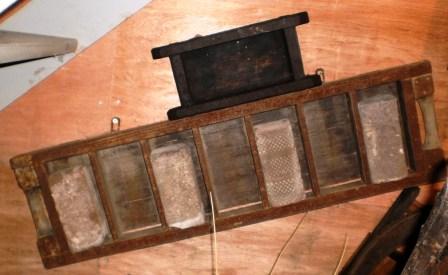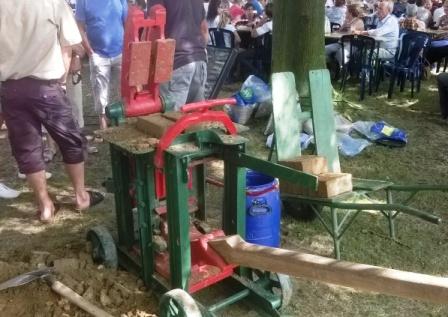A brick is a baked clay block for construction and paving.
 The clay is being cleaned. The clay had one winter to 1 year rot, to digest the organic material out it.
The clay is being cleaned. The clay had one winter to 1 year rot, to digest the organic material out it.
Later came the kneading, grinding, possibly with sand slimming, shaping or molding (without bubbles). Hand molds were first sprinkled with sand. After 1 to 3 weeks drying, started slow baking at a temperature between 900 and 1,100°C. The cooling too takes weeks.
The field kiln is similar to the structure of the charcoal pits. He consisted just out of the baking stone, block-shaped or round (beehive) stacked with between horizontal and vertical channels for combustible material, peat or coal. The top (and outside) was covered with pre- fired bricks (fails of the former kiln). Later it was smeared (“scoved”, to a scove kiln) with clay, but with draw- and smoke holes, and lit there. If the oven is hot enough, these holes were closed and the furnace was allowed to burn out. The firing time was dependent on the clay used, the size of bricks and furnace and the desired quality, but it took at least four weeks. This oven yielded half -fired or half-baked bricks up to melted and sintered bricks. I seem to remember that between some layers of bricks coal was scattered. This led to the typical white spots on the front of the stone.
 The grounds for a field kiln needs to be somewhat hollow, so that the stones shrink and collapse inside and collapse together.
The grounds for a field kiln needs to be somewhat hollow, so that the stones shrink and collapse inside and collapse together.
With fagots the coal is ignited by the fire mouths. After a few hours good fires the mouths are largely closed. The lighting is done at the 9th layer. While the fire settles there is further stacked.
When burning wood and peat, fuel must constantly be added on the windward side until the kiln is fired.
Later they had fixed field kilns, often along major rivers used for transportation. They consisted of one and a half meter thick, twelve to fourteen meter opposite walls. Sometimes there was a binding wall through which a U-shaped kiln was formed. The top was open, sometimes with a tiled roof. Both walls had floor had heating holes (30 × 80 cm) or ’fire mouths’ where a firebreak and flue between the stacked stone was left open.
Here the fireman could thrown tally to keep the fire going and settle it.
The fires were kept low for 24-48 hours to dry the bricks. Steam or "water smoke" escaped from the top of the kiln. When the gases cleared that was the sign to increase the intensity of the fires.
If it was done too soon the steam in the bricks would let them explode. Intense fires were maintained in the fire holes around the clock for a week.
Sometimes there were more than one million bricks stacked. If the oven was full, front and top were densely packed with deck- and shaving stones and insulated with a layer of sand. Heating and smoke vents are kept clear. Fireplaces were stacked with loose stones. For masonry firing temperature was between 900⁰ and 1,125° C, for paving stones between 1,150° C and 1,250⁰C. The stoker could roughly controlle firing by the opening and closing of rifles and fireplaces and adding fuel. First he fired a fortnight a small fire to drive moisture from the stone. Then followed four weeks baking in high heat and finally cool fourteen days. The quality of these stones was a lot better than that of a field kiln, but the differences were not very large. In a favorable case, it was 30% clinker, 30% masonry, 20% inner walls and 20% waste.
Sorters approved the stones on sound and color. They were knocked against each other and scratched with the tip of a brick over another. A hard kind of brick yielded a sharper sound and a white stripe, a softer type a dull sound and a red scratch.
Seller:”13,000 bricks, are you going to build a house?”"No, a barbecue!"
“Then 13,000 is far too much!”“No, I live on the 12 floor!”
